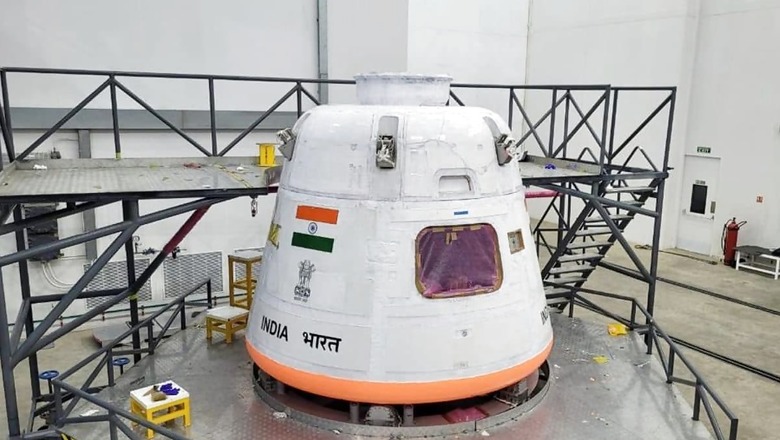
views
India is all set to walk into 2024 armed with a list of ambitious space missions, a skyrocketing ecosystem of space start-ups and an enhanced global reputation. The Indian Space Research Organisation’s (ISRO) growing cosmic prowess has enchanted the world with its innovative and cost-efficient approach.
With the successful Chandrayaan-3 mission and the ambitious Aditya L-1 headed to its destination in space, 2023 has been a power-packed year for India. But if the moon and the sun formed the flavour of ISRO’s 2023 space odyssey, the outlook for 2024 is infused with Venus and Mars, courtesy the Shukrayaan-1 and the Mangalyaan-2 missions.
Meanwhile, the government’s decision to open up the space sector to private players is already bearing fruit. India’s space start-up sector has taken off and is beating all odds. India has witnessed investment of over Rs 1,000 crore in space start-ups in the last nine months. Nearly 190 private space start-ups have emerged within the last four years from just one since the sector was opened up by the government. The policy to throw open the gates of the launch site at Sriharikota has been a popular one among private space players, ushering a new era of private-public partnership in the field.
A Dynamic Year Ahead
ISRO had a fruitful year in 2023 with seven successful launches, including SSLV-D2 in February and the historic Chandrayaan-3 lunar landing. The launch of Aditya-L1, India’s first Sun observatory, is set to reach its destination in early January.
After 2023’s success, here’s how 2024 looks for ISRO. India’s first polarimetry mission, the X-Ray Polarimeter Satellite (XPoSat), the deployment of INSAT-3DS satellites, and NISAR— ISRO’s joint venture with the National Aeronautics and Space Administration are set for launch in the first quarter of next year. The Gaganyaan test flight will also take place in this time period. Following these, the later half of the year may see the launch of the Shukrayaan-1, which involves an orbiter to Venus, and Mangalyaan-2, which will mark ISRO’s second mission to Mars.
NISAR
The NISAR satellite will be an exceptional highlight of 2024. The NASA-ISRO Synthetic Aperture Radar (NISAR) is the world’s largest earth-imaging satellite at $1.5 billion and marks the greatest space endeavour between the US and India so far. The satellite will be launched from Indian soil on board ISRO’s GSLV rocket from the Satish Dhawan Space Centre in Sriharikota. NISAR will observe the entire planet every 12 days and will study land ecosystems, climate, seismic activity and so on.
The applications of such a powerful instrument would be a boon in various fields including agriculture and disaster management. Moreover, it would also cement India and the USA’s collaborative power in the area of diplomacy, as various communities around the world could benefit from the transformative information surge presented by NISAR.
XPoSat
Slated to launch in January, XPoSat (X-ray Polarimeter Satellite) is India’s first and the world’s second polarimetry mission and the third space-based observatory, alongside the recent solar mission Aditya-L1 and the 2015-launched AstroSat. It will measure the polarisation of light waves emanating from different sources such as black holes, hence aiding our understanding of the universe.
According to ISRO scientists, this mission is distinctive and vital as it facilitates the understanding and measurement of emissions from diverse astronomical sources, including black holes, neutron stars, active galactic nuclei, and pulsar wind nebulae—subjects that pose challenges for conventional study.
INSAT 3DS
INSAT 3DS is an advanced meteorological satellite slated for launch early in 2024. It will help predict natural disasters and other weather phenomena, bolstering the country’s understanding of its monsoons, droughts, cyclones and more.
Gaganyaan-1
This will be a test flight for India’s manned space mission slated for launch some time in 2025. It is a collaborative effort between ISRO and Hindustan Aeronautics Limited (HAL).
Shukrayaan and Mangalyaan 2 are in their early stages of development and will be launched tentatively in the later half of 2024.
Needless to say, Indian space enthusiasts have a year of excitement ahead. Each of these missions bears crucial significance for India’s space programme and has applications in various fields that would not only aid the country’s advancement in science but also its people. The missions will also showcase India’s geopolitical prowess and the scope of collaboration with foreign space agencies such as the USA’s NASA as in the case of the NISAR satellite and Roscosmos in Gaganyaan mission design.
Stupendous Surge in Start-ups
India’s space economy is on the rise, driven by a flourishing start-up scene and global interest in its space tech. IN-SPACe, the new space regulator, projects a tenfold increase to $44 billion in the next decade, contributing 8% to the global space economy, up from 2%. IN-SPACe also foresees $22 billion in investments by 2033, signalling substantial sector growth.
With nearly 190 private space start-ups emerging in the last four years rising from just five since the start of the pandemic, the government’s decision to open Sriharikota’s launch site fosters a new era of private-public collaboration.
According to Union Minister Jitendra Singh, India has seen investments exceeding Rs 1,000 crore in space start-ups during the first nine months of the current financial year, spanning from April to December 2023.
ISRO has been closely collaborating with start-ups such as Skyroot Aerospace, Dhruva Space, and Pixxel. Skyroot Aerospace and Dhruva specialise in space launch and satellite delivery, contributing to 8 percent of India’s space industry. Meanwhile, a larger segment of the market is led by companies focused on collecting data transmitted by satellites.
Primed by ISRO
The Indian space industry, valued at around $6 billion this year, offers significant growth potential, expected to triple by 2025. ISRO is actively supporting new private players, leveraging its successful legacy. Positioned advantageously on Sriharikota Island, ISRO’s spaceport is strategically located for orbital missions. The PSLV rocket, renowned for its reliability with a success rate of nearly 95 percent, has made India a competitive global launch site by reducing satellite insurance costs.
To further enhance the private space ecosystem, ISRO is pioneering the transfer of SSLV technology to private entities. In a ground-breaking move on July 11, IN-SPACe facilitated the technology transfer, aligning with the objectives of the recently released Indian Space Policy 2023, aimed at strengthening the country’s private space sector.
Needless to say, Indian space enthusiasts have a year of excitement ahead. Each of these missions bears crucial significance for India’s space programme and has applications in various fields that would not only aid the country’s advancement in science but also its people. The missions will also showcase India’s geopolitical prowess and the scope of collaboration with foreign space agencies such as the USA’s NASA as in the case of the NISAR satellite and Roscosmos in Gaganyaan. At the same time, India also aims to demonstrate once again that it can achieve its highly ambitious goals indigenously with its unique pool of talent and innovative cost-cutting methods.




















Comments
0 comment